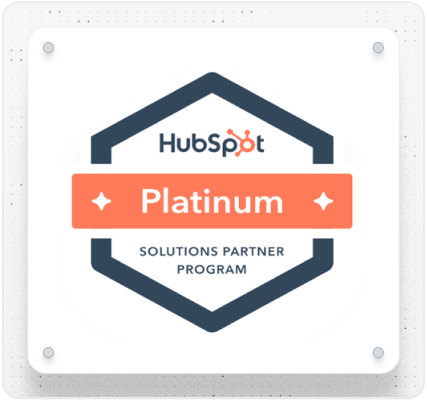- Services
- Build anything in HubSpot
Not sure where to start? Have us evaluate your HubSpot website for free.-

HubSpot Development
Leverage our extensive HubSpot development experience to build anything in HubSpot CMS.
-

Web Design
Redesign a website with a theme, build a custom one, or migrate to HubSpot CMS
-

HubSpot Integrations
Automate workflows with apps, custom objects, HubSpot API integrations & CRM extensions
-

HubSpot Themes
Get our Level Up HubSpot theme, or work with us to build a custom HubSpot theme
-

HubSpot Calculators
Build HubSpot Calculators & Interactive Conversion Tools
-

Shopify Development
Make the most of Shopify themes. Connect with us to build a custom Shopify solution
-

Web Design for Cybersecurity Companies
Secure and scalable HubSpot web design for cybersecurity companies
-
- Build anything in HubSpot
- HubSpot Integrations
- Our Work
- Pricing
- About
- Resources
- Work with Us

4.8/5 Average rating
Salesforce + HubSpot
Integration
Customized to your business needs
Efficient Lead Management
Automatically sync Salesforce with HubSpot for real-time lead updates, ensuring seamless management across both platforms.
01
Efficient Lead Management
Automatically sync Salesforce with HubSpot for real-time lead updates, ensuring seamless management across both platforms.
Enhanced Sales Insights
Leverage HubSpot's marketing data within Salesforce to gain deeper insights into customer behavior, driving more informed sales strategies.
02
Enhanced Sales Insights
Leverage HubSpot's marketing data within Salesforce to gain deeper insights into customer behavior, driving more informed sales strategies.
Streamlined Workflow Automation
Trigger automated sales actions in Salesforce based on marketing activities tracked in HubSpot, aligning your sales and marketing efforts efficiently.
03
Streamlined Workflow Automation
Trigger automated sales actions in Salesforce based on marketing activities tracked in HubSpot, aligning your sales and marketing efforts efficiently.

Connect Salesforce with HubSpot
Teams that level up HubSpot development support with HubBase
-1.png?width=53&height=52&name=Xero_software_logo%201%20(1)-1.png)
Example Workflow Triggers and Actions
Available via Custom Integration. Request a Quote.
New Contact in List
Triggered when a contact is added to a specific list in HubSpot. This can initiate workflows in Salesforce, especially useful for sales follow-ups based on marketing list segmentation.
New Deal Property Change
Activated when a property of a deal in HubSpot is updated. This is crucial for Salesforce to track changes in deal stages or other custom deal properties, aligning sales strategies accordingly.
Product Created or Updated
Fires when a product is either newly created or updated in HubSpot. This is essential for Salesforce to keep track of inventory management and sales tracking.
New Email Event
Triggered by various email activities in HubSpot, such as when an email is opened, clicked, or bounced. This helps Salesforce users to monitor the effectiveness of email campaigns and tailor their sales strategies.
Add Contact to HubSpot List
Adds a contact to a specified list in HubSpot from Salesforce. This can be used for segmenting contacts for targeted marketing campaigns based on sales interactions.
Create a Company in HubSpot
Allows for the creation of a new company record in HubSpot from Salesforce data. This can be triggered by various sales activities, like a successful deal closure or a new lead qualification.
Find Company
Searches for a company in HubSpot. If the company exists, it retrieves details; otherwise, it can trigger the creation of a new company record. This is particularly useful for Salesforce to maintain alignment with marketing data.
Find or Create Line item
Looks for a specific line item in HubSpot. If it doesn't exist, it creates a new one. This action is crucial for syncing e-commerce data between Salesforce and HubSpot.
Find or Create Ticket
Searches for a support ticket in HubSpot. If not found, it creates a new ticket. This ensures that customer service issues tracked in Salesforce are aligned with marketing efforts.
×




Integrations built by experts
Custom Solutions
Tailored HubSpot CRM implementations, app integrations, and tech stack optimization.
Custom Solutions
Tailored HubSpot CRM implementations, app integrations, and tech stack optimization.
Custom Solutions
Tailored HubSpot CRM implementations, app integrations, and tech stack optimization.

11 Years of HubSpot Expertise
Our team is committed to continuous learning, ensuring we deliver cutting-edge solutions and build client infrastructure that scale.





.png?width=357&height=81&name=Frame%20(4).png)




Trusted by 100s of companies from startups to the Fortune 500
120+
HubSpot Websites Built
Top 1%
on Upwork
500+
Custom Integrations Built
 100+ integrations
100+ integrations
Other integrations built by us
Explore a range of custom integrations we've developed to streamline workflows and enhance productivity.

Google Sheets
Enhance data management with HubSpot Google Sheet Integration. Seamlessly sync data between HubSpot and Google Sheets for improved organization and analytics.
Slack
Experience the power of HubSpot Slack Integration. Connect HubSpot with Slack to foster seamless communication and enhance collaboration. Explore the benefits of this integration for improved team efficiency.
QuickBooks
Simplify financial management by integrating HubSpot with QuickBooks. Enhance accuracy and streamline processes for improved business financials.
Salesforce
Discover the benefits of HubSpot Salesforce Integration. Streamline CRM processes by seamlessly connecting HubSpot with Salesforce. Enhance your marketing and sales strategies with this seamless integration.
Wordpress
Explore the advantages of HubSpot WordPress Integration. Seamlessly integrate HubSpot with WordPress for improved marketing workflows and increased efficiency. Elevate your digital strategy with this seamless integration.
Mailchimp
Take your email marketing to the next level! This guide explains how to integrate Mailchimp with HubSpot for powerful automation, better insights, and a more unified customer experience.
Stripe
Optimize payment processing with HubSpot Stripe Integration. Seamlessly connect your HubSpot account with Stripe for efficient and secure transactions.
Asana
Optimize project collaboration by integrating HubSpot with Asana. Streamline communication and workflow for improved efficiency and project success.

Shopify
Optimize your e-commerce marketing with HubSpot Shopify Integration. Streamline workflows and enhance customer engagement for a successful online store.
Zoom
Enhance virtual collaboration with HubSpot Zoom Integration. Seamlessly integrate Zoom with HubSpot for improved communication and collaboration in virtual meetings.
Customer Reviews
-

Carrie Dudley
Director of Client Services -

Ben Oaksmith
Principal & Founder -

Ryan Ondriezek
Associate Creative Director -

Lauren Meeks
Accounting Manager -

Katie Herrmann
Director of Digital Strategy -

Dillon Jones
Digital Marketing Lead -

Tooraj Arvajeh
CEO & Co-Founder

"They excel in communicating directly with clients and third-party software providers."
Illumine8
"HubBase held a feasibility session and mapped out the process for developing custom APIs. They excel in communicating directly with clients and third-party software providers. I strongly recommend them for HubSpot development, Shopify, and API integrations.”

"We highly recommend HubBase."
Oaksmith Yachts
HubBase exceeded our expectations with their expert web development and flawless API integration. Their SEO optimization efforts, tailored to our target audience and industry, led to a dramatic increase in organic traffic and search engine rankings.

"HubBase is by far the best company I've had the privilege to collaborate with"
Amobee
Having worked with a couple of HubSpot developers, HubBase is by far the best company I've had the privilege to collaborate with. Our project was delivered on schedule and met budget, and most important: the email creation system that they provided to my team WORKS.

"An Amazing Partner!"
GossRV
The HubBase team excelled in creating a custom API for HubSpot quotes payments, adapting swiftly to changes with excellent communication. They were incredibly responsive and I highly recommend their team.

"Quick, Quality Dev Work."
Profile Plan
I have really enjoyed working with the HubBase team on a variety of development projects over the last year. We use HubBase as our main website development team, and we rely on them for integration, migration, and HubSpot development work.

"I would absolutely hire them again!”
Dillon Jones, LLC
“The HubBase team did an excellent job handling a complex issue with our HubSpot CMS integration. They helped provide a solution that made sense for the business and ensured a quality end result.

"I highly recommend working with this team."
Perl Street
HubBase built our software platform very scalable as it utilized serverless Amazon AWS. The backend and frontend of the platform is developed using JavaScript. It has integrations with HubSpot, Quickbooks and HelloSign.

"They excel in communicating directly with clients and third-party software providers."
Illumine8
"HubBase held a feasibility session and mapped out the process for developing custom APIs. They excel in communicating directly with clients and third-party software providers. I strongly recommend them for HubSpot development, Shopify, and API integrations.”

"We highly recommend HubBase."
Oaksmith Yachts
HubBase exceeded our expectations with their expert web development and flawless API integration. Their SEO optimization efforts, tailored to our target audience and industry, led to a dramatic increase in organic traffic and search engine rankings.

"HubBase is by far the best company I've had the privilege to collaborate with"
Amobee
Having worked with a couple of HubSpot developers, HubBase is by far the best company I've had the privilege to collaborate with. Our project was delivered on schedule and met budget, and most important: the email creation system that they provided to my team WORKS.

"An Amazing Partner!"
GossRV
The HubBase team excelled in creating a custom API for HubSpot quotes payments, adapting swiftly to changes with excellent communication. They were incredibly responsive and I highly recommend their team.

"Quick, Quality Dev Work."
Profile Plan
I have really enjoyed working with the HubBase team on a variety of development projects over the last year. We use HubBase as our main website development team, and we rely on them for integration, migration, and HubSpot development work.

"I would absolutely hire them again!”
Dillon Jones, LLC
“The HubBase team did an excellent job handling a complex issue with our HubSpot CMS integration. They helped provide a solution that made sense for the business and ensured a quality end result.

"I highly recommend working with this team."
Perl Street
HubBase built our software platform very scalable as it utilized serverless Amazon AWS. The backend and frontend of the platform is developed using JavaScript. It has integrations with HubSpot, Quickbooks and HelloSign.
Efficient Lead Management
Automatically sync Salesforce with HubSpot for real-time lead updates, ensuring seamless management across both platforms.
Enhanced Sales Insights
Leverage HubSpot's marketing data within Salesforce to gain deeper insights into customer behavior, driving more informed sales strategies.
Streamlined Workflow Automation
Trigger automated sales actions in Salesforce based on marketing activities tracked in HubSpot, aligning your sales and marketing efforts efficiently.
×




Hubspot integration FAQs
Hubspot integration FAQs
Integration questions demystified for marketing teams
How does integrating Salesforce with HubSpot benefit lead management?
Can I sync Salesforce opportunities with HubSpot deals seamlessly?
Is data synchronization between HubSpot and Salesforce real-time?
How does the integration enhance sales and marketing alignment?
Can I track HubSpot marketing campaigns in Salesforce?
Can Salesforce reports include marketing data from HubSpot?
How does the integration handle contact and lead duplication?
Can I create and manage HubSpot email campaigns based on Salesforce data?
Is it possible to customize the data fields that sync between HubSpot and Salesforce?
How does the integration impact lead scoring and qualification?
How does integrating Salesforce with HubSpot benefit lead management?
The integration allows for seamless data flow between HubSpot and Salesforce, ensuring that lead information is consistent and up-to-date across both platforms, enhancing lead management processes.
Can I sync Salesforce opportunities with HubSpot deals seamlessly?
Yes, opportunities in Salesforce can be synced with deals in HubSpot, providing a unified view of the sales pipeline.
Is data synchronization between HubSpot and Salesforce real-time?
Data synchronization is near real-time, ensuring that changes in one system are quickly reflected in the other.
How does the integration enhance sales and marketing alignment?
By sharing data between HubSpot and Salesforce, sales and marketing teams can align their strategies and actions based on a unified set of data, improving collaboration and efficiency.
Can I track HubSpot marketing campaigns in Salesforce?
Yes, the integration allows you to track the performance of HubSpot marketing campaigns directly within Salesforce.
Can Salesforce reports include marketing data from HubSpot?
Yes, Salesforce reports can include HubSpot marketing data, providing a comprehensive view of your sales and marketing performance.
How does the integration handle contact and lead duplication?
The integration includes mechanisms to prevent duplication, ensuring that contacts and leads are consistently managed across both platforms.
Can I create and manage HubSpot email campaigns based on Salesforce data?
Absolutely. You can leverage Salesforce data within HubSpot to create targeted email campaigns, enhancing the relevance and effectiveness of your marketing efforts.
Is it possible to customize the data fields that sync between HubSpot and Salesforce?
Yes, you have the flexibility to customize which data fields sync between HubSpot and Salesforce, allowing you to tailor the integration to your specific needs.
How does the integration impact lead scoring and qualification?
The integration allows you to use combined data from both platforms for more accurate lead scoring and qualification, enhancing the effectiveness of your sales funnel.
The integration allows for seamless data flow between HubSpot and Salesforce, ensuring that lead information is consistent and up-to-date across both platforms, enhancing lead management processes.
Yes, opportunities in Salesforce can be synced with deals in HubSpot, providing a unified view of the sales pipeline.
Data synchronization is near real-time, ensuring that changes in one system are quickly reflected in the other.
By sharing data between HubSpot and Salesforce, sales and marketing teams can align their strategies and actions based on a unified set of data, improving collaboration and efficiency.
Yes, the integration allows you to track the performance of HubSpot marketing campaigns directly within Salesforce.
Yes, Salesforce reports can include HubSpot marketing data, providing a comprehensive view of your sales and marketing performance.
The integration includes mechanisms to prevent duplication, ensuring that contacts and leads are consistently managed across both platforms.
Absolutely. You can leverage Salesforce data within HubSpot to create targeted email campaigns, enhancing the relevance and effectiveness of your marketing efforts.
Yes, you have the flexibility to customize which data fields sync between HubSpot and Salesforce, allowing you to tailor the integration to your specific needs.
The integration allows you to use combined data from both platforms for more accurate lead scoring and qualification, enhancing the effectiveness of your sales funnel.
Book a consultation call
Copyright © 2025 HubBase, Inc.